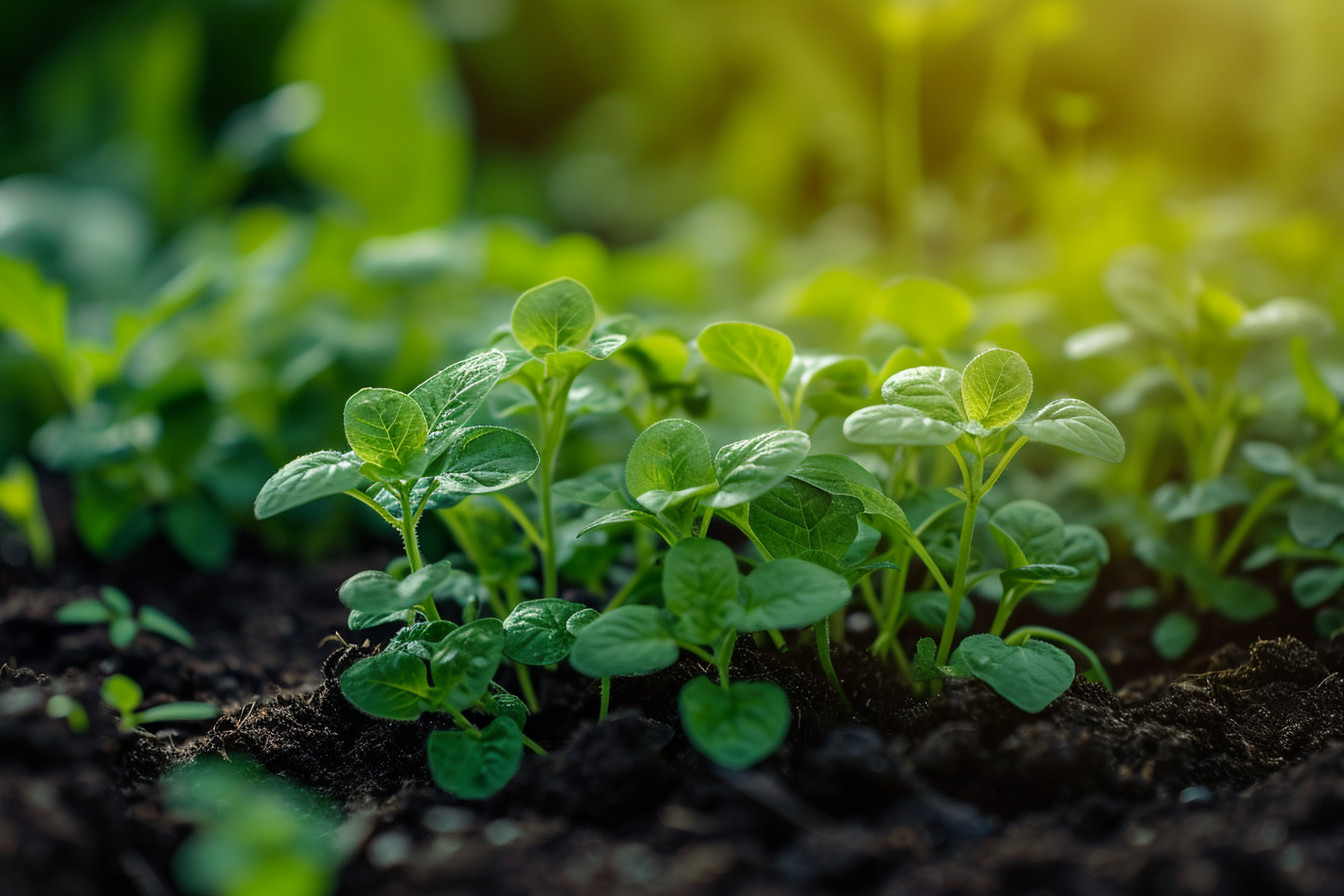Ever found yourself starin’ at that blank fence or bare balcony wall, just wishin’ it could be more? That’s where vertical gardening comes in, my friends. It’s not just a space-saver; it’s a game changer for folks lookin’ to get the most out of their green patches, no matter how small.
I’ve been down this road, turning every nook and cranny into a lush oasis. It’s about thinkin’ up, not out, and trust me, the yields can be mind-blowing. So, let’s dive into some savvy tips to help you maximize your harvest and make those vertical dreams a bloomin’ reality.
Benefits of Vertical Gardening
When I started exploring the serene world of vertical gardening, I was seeking not just a method to grow more in less space, but also a way to surround myself with peace and greenery. There’s something genuinely harmonious about tending to a vertical garden. It’s like each plant is a living, breathing entity that contributes to a sense of calm in my world.
For folks like me living in urban sprawls with rather cramped quarters, vertical gardening is a godsend. It lets us cultivate a diverse array of plants, herbs, and even small root vegetables. These gardens become not just a source of fresh produce but also a focal point for natural beauty and tranquility in our homes.
The first time I decided to “think up” for my sprawling urban garden, I was amazed at how it transformed a once drab space into a lush, green oasis. Is there anything more peaceful than sipping your morning coffee surrounded by verdant foliage and the subtle fragrances of blooming flowers? I doubt it.
Vertical gardening is more than a trend; it’s part of an educational journey that introduces us to new techniques like hydroponics and companion planting. I’ve learned how these methods not only boost my garden’s productivity but also help manage pests and diseases organically, ensuring a healthier ecosystem for my plants to flourish.
Remember Square Foot Gardening? This revolutionary movement echoed the ethos of making the most out of limited space. Vertical gardening is no different. It also presses the boundary of traditional gardening spaces, allowing us to grow upwards and make use of every possible inch of room.
Mental and physical health benefits are a big part of why I love this form of horticulture. Watching a plant unfurl its leaves or a flower come into bloom right outside my window brings a sense of achievement and connection to the world around me. Plus, it’s a low-impact activity that gets my body moving without the strain that traditional gardening can sometimes bring.
Technical Tips Made Simple: If you’re new to this, don’t worry! It’s all about starting with the basics—good soil, the right plants, and a sturdy structure. These elements are the foundation of your vertical garden. Sure, there are fancy terms like “aeroponic systems” or “soil pH,” but all they really refer to are ways to deliver nutrients to your plants and getting the dirt ‘just right’ for your plant babies to thrive.
Choosing the Right Plants
When I first peered into vertical gardening, the array of plant choices was as vast as a kid’s gaze upon a candy store—it’s easy to get lost in the colors and varieties. But after plenty of trial and error, I’ve learned that not every plant is suited for vertical life. It’s like picking the right friends to journey with you; you’ve got to know who will thrive alongside you up in the air.
Herbs are my go-to for vertical gardens. They don’t need much root space and are incredibly forgiving if I forget a watering here and there. Herbs like basil, mint, and chives have never failed to add both greenery and aroma to my little hanging oasis. Plus, there’s nothing quite like clipping fresh herbs right before tossing them into a pot on the stove—it feels, I don’t know, reassuringly self-sufficient.
Next, let’s talk about succulents. Oh, how these little troopers can make any vertical space pop with so little fuss! They’re practically made for the high-rise garden life with their low water needs and love for the sun. Even on days when the city feels overwhelming, my succulent wall is a slice of peace, each one content in their snug pockets of soil.
But maybe you’re in it for the long haul and fancy something fruit-bearing. Strawberries are a sweet bet. They love going vertical and can yield a pretty darn good harvest. Picture this: a cascade of cheery red berries right outside your window. It’s a living piece of art that also happens to be delicious.
Vegetables? Yes, they can join the high-rise party too, especially the leafy greens. Spinach, lettuce, and kale don’t ask for much—just some good soil, a bit of care, and they give back in spades. There’s this unmistakable satisfaction in watching greens burst into life, knowing they’ll end up as part of your dinner salad. It’s fulfilling in a way that goes beyond just food.
If flowers are your jam, then petunias and begonias are your friends. Vibrantly colored with a will to spill over their containers, they’re nature’s waterfall of color. They’re also pollinator magnets, which means your vertical garden could become a buzzing hub of bees and butterflies, a tiny ecosystem clinging to the side of your home.
Selecting the Perfect Location
Finding the right spot for your vertical garden isn’t just about the aesthetics; it’s where you create a serene oasis. I’ve always felt that standing among my plants, there’s this undeniable connection, a gentle whisper between nature, and me, reminding us of the harmony we share. And that’s what you want to achieve – a space that not only grows food or flowers but also cultivates peace.
When I talk about the perfect place, you’ve got to consider light exposure. After all, photosynthesis isn’t just a fancy word from science class; it’s the lifeline for your garden. Most herbs and leafy greens need a good amount of sunlight, around six hours a day, to thrive. But if you’re working with less sunny spaces, don’t you fret! There are plenty of plants that can handle the shade, like ferns or certain types of ivy.
Air Circulation plays a huge role too. It’s like the silent sentinel that wards off the mildew and pests. I’ve learned, after much trial and error, that cramming plants too close might lead them to suffocate – literally and figuratively. Leave some breathing room between your plants. Make sure the spot you’ve chosen gets a gentle breeze from time to time—just enough to rustle through the leaves.
Accessibility isn’t just a buzzword; it’s vital for regular maintenance. Imagine you’ve set up your vertical garden on a lofty wall with no easy way to reach it. It might look nice from afar, but it’s no good if you can’t easily water, prune, or harvest your plants. You’ll want your garden within arm’s reach for hassle-free care.
The location’s also gotta tell a story – yours. Maybe it’s close to your kitchen window, where every morning you can snip fresh herbs while the aroma mingles with the scent of coffee brewing. Or it might be that cozy corner on the patio, where you’ve watched ladybugs march over your petunias. Each spot in your garden adds a paragraph to the tale of your green thumb.
Building Vertical Structures
Crafting my vertical garden, the structures I use aren’t just functional; they’re the canvas for my growing oasis. I like to think that the quiet assembly of these supports is a step toward creating harmony between my plants and the urban backdrop.
Upright frames and trellises are foundational for climbers like ivy or beans. Picking the right material matters. I’ve found that cedar and redwood resist rot well, which means more peaceful years enjoying my garden without the hassle of frequent repairs. Plus, they’ve got this natural charm that just meshes with the vibe I’m going for.
I learned that using modular systems — like stackable planters and adjustable supports — lets me customize my space as the garden evolves. This flexibility paved the way for experiments, leading to some of my best harvests yet. I realized that vertical gardening isn’t static; it’s dynamic and endlessly adaptable, much like nature itself.
It’s easy to forget about planters and containers when you’re focused on the vertical aspect, but they’re key for efficient water use and soil containment. I’ve seen many gardens where creativity blooms in the choice of containers – repurposed wood boxes, old pipes, or even designer pots. Whatever suits the narrative of your garden and resonates with your soul, go for it!
Installing automated drip irrigation systems changed the game for me. There’s a simple beauty in knowing my plants receive just the right amount of water, gently, like a calm summer rain. It mirrors the balance I seek in life; it’s the technical meeting the meditative.
Enhancing air circulation can’t be overstressed. I’ve spaced out my structures to invite a gentle dance of air between the leaves. This isn’t just practicality speaking; there’s a certain peace that comes with the sight of foliage lightly swaying in the breeze.
Once, I visited a garden where the structures lined up with the rising sun; the gardener used the alignment to create a shadow play every morning. The beams cut through the leaves, casting intricate patterns on the ground, inviting stillness and awe. It was simple, yet it spoke volumes about how our constructs can tap into the rhythm of the day.
Watering and Irrigation Techniques
When it comes to vertical gardening, the serene trickle of water moving through the system is one of the most peaceful aspects of the process. It’s a time for me to slow down and connect with my plants, ensuring they’re receiving just what they need. I’ve learned over the years that efficient watering is key to maximizing yields, and it’s surprisingly simple once you get the hang of it.
Watering by hand can be therapeutic, really. It’s a chance to inspect each plant, marvel at the new growth, and spot any early signs of distress. But let’s be honest, hand watering isn’t the most efficient way, especially as your garden grows. That’s when irrigation systems come into play.
Automated drip irrigation is a game-changer in the vertical garden. It delivers water directly to the roots, reducing waste and the risk of diseases that thrive in overly wet foliage. And the best part? It frees up more time for you to simply enjoy the garden. I like to start my mornings with a cup of coffee, listening to the soft hiss of my drip lines at work—it’s a perfect start to the day.
When I first started out, I was lost in a maze of terms like “soaker hoses” and “emitters”. Here’s a breakdown for you:
- Soaker hoses: These hoses have small pores that allow water to seep out slowly, perfect for a gentle watering approach
- Emitters: These are devices that can be adjusted to release a certain amount of water per hour, making it easy to customize irrigation for different plants
I once visited a green space that was a testament to vertical gardening done right. Their irrigation system was a mix of soaker hoses and emitters, tailored to each plant variety’s specific needs. They tracked their watering meticulously and saw a decrease in water usage by about 70% compared to traditional methods, all while their plant yields soared. It was astonishing.
But how do you keep track? I started with a simple logbook, jotting down timings, amounts, and weather conditions. Nowadays, there are smart irrigation controllers that connect to Wi-Fi and adjust the watering schedule based on local forecasts. Talk about convenience!
Soil and Fertilizer Requirements
When I’m nestling seeds into their vertical homes, I can’t help but feel a profound connection to the earth. It’s like I’m tapping into an ancient ritual, adopting age-old practices in the heart of the modern world. Yet even in vertical gardening, the essence of this ritual remains rooted in the soil—its quality, its nourishment. Good soil isn’t just dirt; it’s a living, breathing foundation that gives my green friends the strength to reach toward the sky.
I’ve learned over time that the best yields in vertical gardening come from a blend of light and loose soil. It allows roots to spread out and absorb nutrients effortlessly. But what’s the ideal mixture? I’ve found a blend of peat moss, perlite, and compost is perfect. This mix retains moisture while providing excellent aeration, two crucial factors that are particularly important when gardening vertically.
Choosing the Right Fertilizer
Each plant whispering through my green wall has its own language, its own needs—especially when it comes to nutrients. In the world of vertical gardening, fertilizer is more than food; it’s a delicate balance meant to mimic the bounty of the earth. There’s no ‘one-size-fits-all’ here. I select my fertilizers based on what each plant variety craves.
Typically, I opt for:
- Organic options: These give my plants a healthy buffet of nutrients without the harsh chemicals.
- Slow-release fertilizers: They’re like a trusty friend, consistently feeding my plants over time.
- Liquid fertilizers: With these, I can easily adjust nutrient levels according to the growth stage of my plants.
In my narrative of nurturing, I write many chapters, but one that’s particularly important is the cycle of fertilizer application. I’ve learned to read the signs—yellowing leaves might signal nitrogen deficiency, while stunted growth could be a cry for phosphorous.
Monitoring and Adjusting Soil pH
The pH level of the soil is like the mood of a great novel—it sets the tone for everything that follows. It’s not just a number; it’s a measure of the soil’s acidity, which affects how plants absorb nutrients. I’ve seen firsthand how a pH imbalance can turn a thriving garden into a withered patch.
Pests and Disease Management
Managing pests and diseases is pretty much like a serene game of chess between gardener and nature. Even in the controlled chaos of a vertical garden, critters and blights find a way to bring a bit of wild into our cultivated spaces. As much as I love feeling connected to the earth’s rhythms, it’s vital to keep an eye out for unwelcome guests looking to feast on your hard work.
Maintaining a pest-free garden often starts with Prevention. I’ve learned over the years that healthy plants are less susceptible to disease and insect attacks. So keep that soil blend rich and monitor each plant’s health. And here’s a trick I swear by—strong airflow. Sure, it keeps me cool while I tend to my leafy friends, but more importantly, it helps deter those pesky aphids and mites that thrive in stagnant air.
Choosing the right companions for your vertical setup can also be a game-changer. Some plants, like marigolds and nasturtiums, are basically nature’s bouncers, keeping pests away with their unique scents. They don’t just add to your garden’s aesthetic, they’re on the front lines in pest management!
But despite our best efforts, sometimes pests sneak in. That’s when the Integrated Pest Management (IPM) strategy comes into play. IPM is a thoughtful approach, blending cultural, physical, biological, and chemical methods:
- Regularly inspecting plants for early signs of infestation.
- Introducing beneficial insects like ladybugs to eat soft-bodied pests.
- Applying insecticidal soaps or neem oil as a last resort.
And as for diseases, prevention is also key. I learned the hard way that proper spacing is crucial—not just for growth but also for keeping diseases from spreading like a high school rumor. Fungal diseases love moisture, so I always water my plants at the base to avoid wet leaves. And if a plant does catch something, it’s best to remove it promptly to prevent the spread.
Remember how I mentioned soil pH and nutrients earlier? It turns out that keeping that balance isn’t just about the nutrients. A stable pH can actually help prevent some diseases. It’s fascinating when you think about it—the ground beneath our feet, often overlooked, silently defending its residents.
Harvesting and Maintaining Yields
Gazing at a lush green wall brimming with ripe veggies and fruits, I’m reminded that harvesting isn’t just a chore, it’s a gentle dance with nature. The quiet moments spent snipping fresh produce are filled with a sense of peace and connection to the earth that’s both calming and invigorating.
I’ve learned that timing is critical when it comes to harvesting in vertical gardens. Veggies like tomatoes and lettuce send clear signals — a rich, vibrant color for tomatoes and full, tender leaves for lettuce. I always suggest keeping a keen eye on your garden’s bounty to pick them at their peak.
But it doesn’t end with harvesting. Maintaining yields is akin to nurturing a continuing story; each chapter enriched with the promise of growth. Here’s some knowledge I’ve gathered along the winding garden paths:
- Consistent Care: Regularly check plants for signs of distress, like wilting or discoloration. Just like with pest management, catching issues early can keep your garden thriving.
- Succession Planting: This is a magician’s trick I adore. By planting seeds at staggered intervals, you ensure a continuous supply of crops — the show never stops.
- Pruning and Deadheading: Removing dead or overgrown parts of plants isn’t just cleanup; it’s an invitation for new growth, keeping the garden’s life cycle spinning.
I often draw lessons from history when it comes to agriculture. The Hanging Gardens of Babylon were one of the seven wonders for a reason, and that ancient wisdom of creating fertile, upward-growing oases in the middle of arid lands? It’s alive in every vertical garden, where space is smartly used to conjure abundance.
You don’t have to be an expert to grasp the technical side of things. Here’s a term you might come across: ‘bolting’. This is when plants like lettuce start to seed prematurely, often due to high temperatures, making them bitter. So, in warmer climates, picking them early and often can be your mantra.
I remember an urban gardener who transformed her cramped rooftop into a verdant paradise using vertical gardens. She’d integrate story with soil, saying her harvests weren’t just about food; they painted pictures of resilience and community spirit. Her success wasn’t only measured in pounds of produce but in the joy of sharing her harvest with neighbors.
Final Thought
Alright, let’s wrap this up! I’ve walked you through the ins and outs of making the most of your vertical garden space. Remember, it’s all about being proactive with pest management and keeping an eye out for any signs of trouble. Harvesting at just the right time and keeping up with the maintenance will ensure your greens are thriving. And hey, if you’re like the urban gardener I mentioned, you might just end up with a lush rooftop oasis of your own. Here’s to hoping you’ll be sharing your bounty with the community before you know it. Happy gardening!










